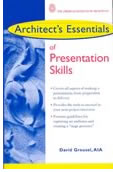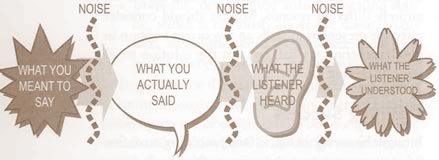
The fantastic Architect's Essentials of Presentation Skills offers public speaking as performance art
 Architect's
Essentials of Presentation Skills by David Greusel, AIA, (John
Wiley & Sons, 2002), fourth in this year's "Architect's Essential
Series" on best practice skills, presents all aspects of presentation,
from preparation to delivery, provides the tools to succeed in project
interviews, and offers guidelines on creating that ineffable sense of
"stage presence."
Architect's
Essentials of Presentation Skills by David Greusel, AIA, (John
Wiley & Sons, 2002), fourth in this year's "Architect's Essential
Series" on best practice skills, presents all aspects of presentation,
from preparation to delivery, provides the tools to succeed in project
interviews, and offers guidelines on creating that ineffable sense of
"stage presence."
This is a really great book to help you coach yourself through a lot of public speaking situations—from presenting to an audience of thousands, a five-person client meeting, or a one-on-one conversations with the boss—with which many architects may not be naturally facile or comfortable and certainly are not trained. Greusel, himself a principal of HOK Sport + Venue + Event, Kansas City, consistently rates as one of the favorite presenters at AIA conventions, a venue through which he has polled architects about their worst presentation nightmares. These are remarkably consistent he says (the list is in the book), and he succeeds in offering techniques to build the skills needed to conquer the dragons.
 The
Ten Commandments
The
Ten Commandments
Greusel divides his text into 10 chapters, which he dubs "The Ten
Commandments of Presentation" and describes as:
1. Show Up: An investigation of
the physical quality of presentations, use of the body, stage presence,
and a discussion of appropriate movement
2. What's My Motivation? Understanding
the goal of your presentation and how to use that goal to motivate every
statement, visual image, and action request in your presentation
3. Know Your Lines. A discussion
of the importance of preparation in delivering successful and compelling
presentations and, especially, on the distinction between preparing and
rehearsing; here you will discover the two keys to winning presentations:
mastery of the topic and the paradox of practicing
4. Find Your Light: Looking at the
physical environment in which a presentation is to occur, preparing the
space, and preparing yourself to be seen and heard in it
5. Face Out. A discussion of the
five aspects of presenting that keep audiences involved: energy, empathy,
engagement, enthusiasm, and entertainment
6. Keep Going. Dealing with obstacles
and breakdowns in a presentation, especially when your options are limited
7. Project. How to make yourself
heard in different presentation venues
8. Be in the Moment. A discussion
of focus and concentration and the importance of maintaining intensity
at the time of your presentation
9. Remember Your Props. Consideration
of various types of visual aids used by architects, and their pluses and
minuses
10. Know When to Get Off. How pace
and timing affect the delivery of a presentation, as well as a discussion
of stage management techniques and managing multiple presenters.

Be in the moment
In little gray boxes in the reader's margins, Greusel peppers Presentation
Skills with "Tips" (you should plan for as many predictable
obstacles as possible), "Warnings" (often, architects become
so enamored with their own drawings that they end up talking to the drawings
instead of to the audience), "Reminders" (if the audience can't
see you, they can't hear you either), and "Rules of Thumb" (one
of the biggest obstacles to enthusiasm is tension felt by the presenter).
There is a lot of solid practical information packed into every page.
Arguably, however, there is information a tad more abstract but equally—and
then some—critical in the "Be in the Moment" chapter. In
the author's words:
 "'In
the moment' is a phrase you hear in connection with performing arts, psychology,
and occasionally with sport, usually in the form of a counterpart phrase,
'in the zone.'It refers to a level of focus and concentration that most
people, in their everyday lives seldom aspire to or attain. But being
in the moment is absolutely critical to delivering a successful presentation
and accomplishing your objective. It requires you to devote 100 percent
of your resources—physical, emotional, mental—to the task at
hand, which is presenting. It's not enough to call it commitment, because
commitment can be expressed in a variety of ways. A person who spends
ninety hours a week at work is said to be committed, but how much of that
time does he or she spend surfing the Internet or passing the time with
coworkers? Being in the moment is a different level of commitment, the
total commitment of self to a task or activity. . . .
"'In
the moment' is a phrase you hear in connection with performing arts, psychology,
and occasionally with sport, usually in the form of a counterpart phrase,
'in the zone.'It refers to a level of focus and concentration that most
people, in their everyday lives seldom aspire to or attain. But being
in the moment is absolutely critical to delivering a successful presentation
and accomplishing your objective. It requires you to devote 100 percent
of your resources—physical, emotional, mental—to the task at
hand, which is presenting. It's not enough to call it commitment, because
commitment can be expressed in a variety of ways. A person who spends
ninety hours a week at work is said to be committed, but how much of that
time does he or she spend surfing the Internet or passing the time with
coworkers? Being in the moment is a different level of commitment, the
total commitment of self to a task or activity. . . .
"Part of being in the moment is the recognition that every design professional wears many hats and plays many roles, of which being a design professional is only one. We are not as single-minded as our resumes and our performance reviews would have us (and others) believe. We are enormously complex creatures with amazing abilities to think about more than one thing at a time. There is nothing wrong with having more than one thing going on in your head most of the time—don't most of the people in your office listen to music while they design? The only time it is wrong to be multitasking is when you are presenting. . . .
"There are two main obstacles to being in the moment: the past and the future. The moment, of course, is right now, and being in the moment means bringing your full personality to bear on the activity taking place this second, whether you are speaking or not."
Copyright 2002 The American Institute of Architects. All rights reserved.
![]()
|
Architect's Essentials
of Presentation Skills by David Greusel, AIA, (John Wiley
& Sons, 2002) is fourth in this year's "Architect's Essential
Series" on best practice skills. Each book is $32 AIA members/$35 retail (plus $6 shipping per order). To order from the AIA Bookstore, phone 800-242-3837 option #4; fax 202-626-7519; or send an email. Architecture as Performance Art II: The Art of Listening, by David Greusel, is just one of the many distance-education courses offered through AIA eClassroom. For more information about the course, click here. Also, check out the complete list of eClassroom courses. |
|